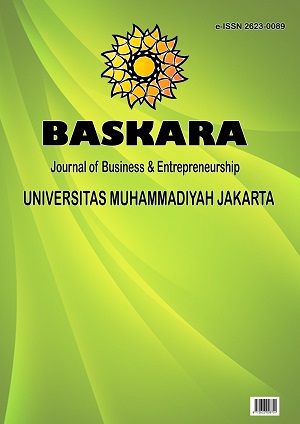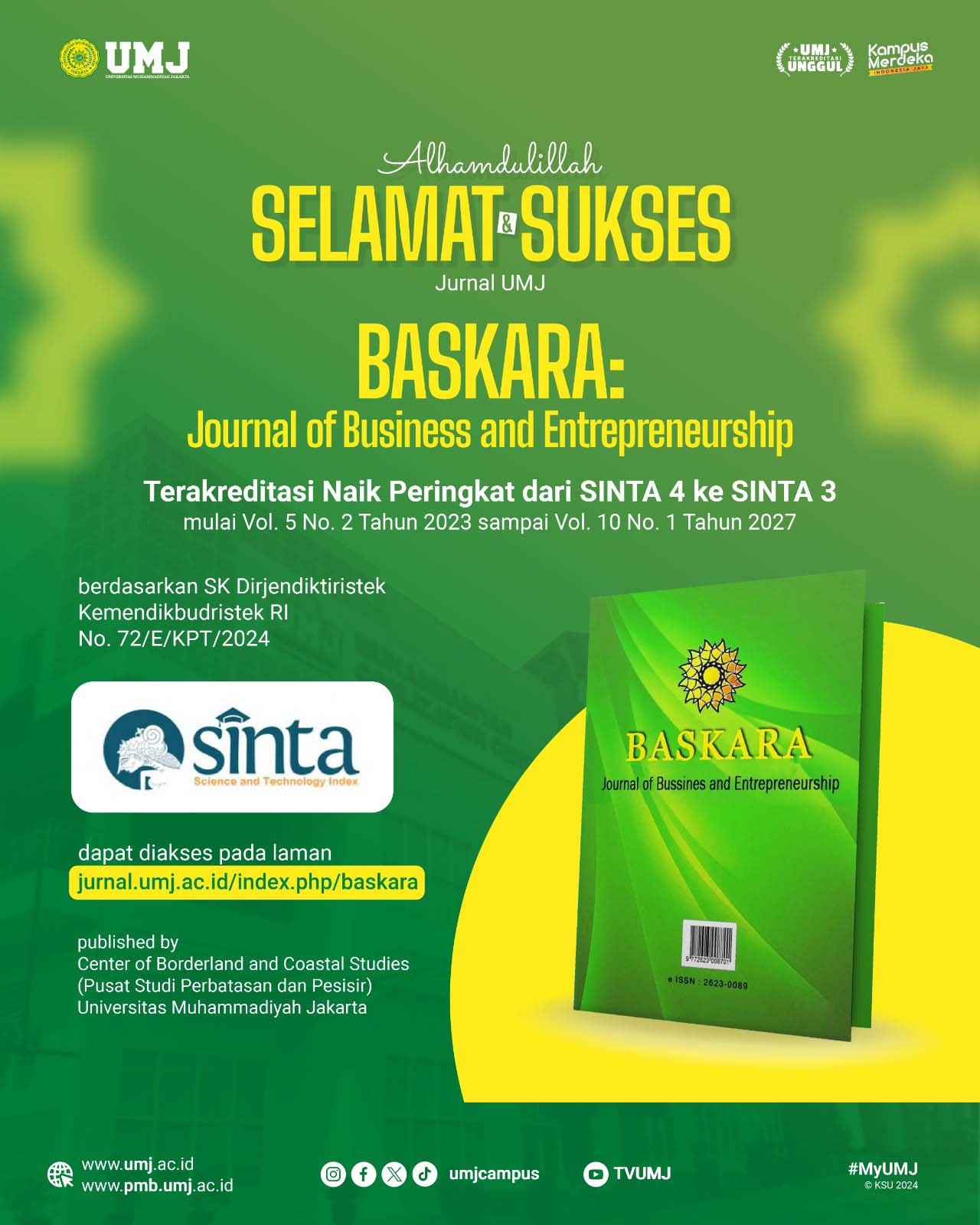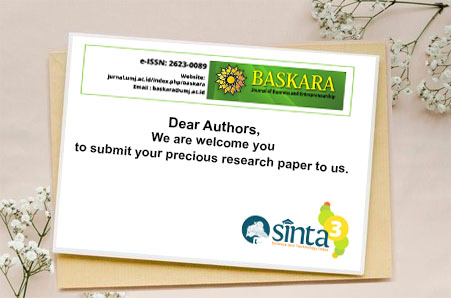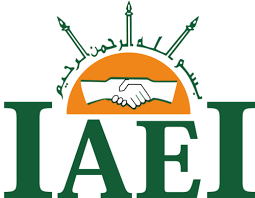Canvas Model Business Design (BMC) in Karawang Batik Production Business at Bale Batik Taza Karawang
DOI:
https://doi.org/10.54268/baskara.v4i1.9756Keywords:
Business Model Canvas (BMC), SWOT AnalysisAbstract
The research objective is to implement the Design strategy to develop the Karawang Batik Business by using the design of the nine elements of the Canvas business model which includes Customer segment, value proposition, channel, customer relationship, revenue stream, key resources, key activities, key partnership, cost structure. This Canvas Model is expected to be able to overcome and provide solutions to problems and obstacles from all activities or activities at Bale Batik Taza Karawang which until now seems to have not been fully implemented so that researchers want to create, map, design, and direct what indicators should be improved to build a business that it can produce maximum production, marketing, and sales. The type of research used is descriptive with a qualitative approach method. The research location was conducted at Bale Batik Taza, KH. Ahmad Dahlan street No.20 at Karawang city. Respondents were carried out purposively by considering the factors of understanding the company's strategy, company conditions, internal conditions, business models, the company's main competitors. alternative Strength–Opportunity strategy as a strategy to use strengths to take advantage of existing opportunities. The conclusion of the research that can be found is that the mapping of the Canvas business model run by Bale Batik Taza Karawang has not been maximally implemented. Some elements that need to be improved are Key partnership, Key Resource, Key Activity, Customer Relationship, Customer segment, Channel, and Cost Structure. While the approach using SWOT analysis should be more maximal in developing its business innovations such as expanding marketing strategies, networking with vendors, and the quality of the various designs and variations of the typical Karawang batik patterns that are packaged according to consumer demand so that they will be satisfied with the results of the pattern designs made. The strategy is carried out using the S–O, S–T, W–T, and W-O to determine how many strategies can be used to build and develop the Karawang Batik Business at Bale Batik Taza Karawang so that it can increase.References
Ansory, E. S. (2017). Berjualan Baju (Distro) Dengan Strategi Canvas Bisnis Model. https://www.academia.edu/34199432/Berjualan_Baju_Distro_Dengan_Strategi_Canvas_Bisnis_Model
Arikunto, S. (2016). Prosedur Penelitian: Suatu Pendekatan Praktik (VI). PT.Rineka Cipta.
Grandhia Agil Patria, Endang Chumaidiyah, W. T. (2018). Perancangan Model Bisnis Online Shop Leclaire.id Dengan Menggunakan Pendekatan Business Model Canvas. E-Proceeding of Engineering, 5(3), 6820–6827. https://openlibrarypublications.telkomuniversity.ac.id/index.php/engineering/article/view/7905
Huberman, A. M., & Miles, M. B. (1992). Analisis Data Kuantitatif. UI Press.
Hunger., T. L., & David, W. J. (2012). Strategic Managment and Business Policy: Toward global sustainability (13th ed.). Pearson Education.
Kotler & Keller. (2009). Manajemen Pemasaran, Edisi Millenium, Jilid 1 (12th ed., Vol. 1, Issue 2). Erlangga.
Moleong, L. J. (2014). Metodologi Penelitian Kualitatif, (Revised Ed). Remaja Rosdakarya.
Nasution, A. (2019). Business Model Canvas Fashion Busana Muslim Di Jakarta. Jurnal Dinamika Manajemen Dan Bisnis, 2(1), 42–53. https://doi.org/10.21009/jdmb.02.1.3
Osterwalder, A., & Pigneur, Y. (2012). Business Model Generation. Journal of Chemical Information and Modeling, 53(9). PT Elex Media Komputindo.
Pearce, & Robinson. (1997). Pengertian Definisi Manajemen Strategis (12th ed.). Salemba 4.
Rangkuti, F. (2017). Pengertian dan Rancangan Diagram Analisis SWOT. Bumi Aksara.
Sofyan Syafri, H. (2013). Analisis Kritis atas Laporan Keuangan. PT.Raja Grafindo Persada.
Sugiyono. (2012). Metode Penelitian Kuantitatif, Kualitatif dan R&D. Alfabeta.
Sugiyono. (2018). Metode Penelitian dan Pengembangan: Reserch and Development. Alfabeta.
Downloads
Published
Issue
Section
License
In order for Baskara: Journal of Business and Entrepreneurship to publish and disseminate research articles, we need publishing rights (transfered from author(s) to publisher). This is determined by a publishing agreement between the Author(s) and Baskara Journal. This agreement deals with the transfer or license of the copyright of publishing to Baskara: Journal of Business and Entrepreneurship, while Authors still retain significant rights to use and share their own published articles. Baskara : Journal of Business and Entrepreneurship supports the need for authors to share, disseminate and maximize the impact of their research and these rights, in any databases.
As a journal Author, you have rights for a large range of uses of your article, including use by your employing institute or company. These Author rights can be exercised without the need to obtain specific permission. Authors publishing in Baskara : Journal of Business and Entrepreneurship have wide rights to use their works for teaching and scholarly purposes without needing to seek permission, including:
- use for classroom teaching by Author or Author's institution and presentation at a meeting or conference and distributing copies to attendees;
- use for internal training by author's company;
- distribution to colleagues for their reseearch use;
- use in a subsequent compilation of the author's works;
- inclusion in a thesis or dissertation;
- reuse of portions or extracts from the article in other works (with full acknowledgement of final article);
- preparation of derivative works (other than commercial purposes) (with full acknowledgement of final article);
- voluntary posting on open web sites operated by author or author’s institution for scholarly purposes.
Copyright Transfer Agreement for Publishing (Publishing Right)
The Authors who submit manuscript has to understand that if accepted for publication, mean that all copyright and publishing right of the article shall be assigned/transferred to Baskara: Journal of Business and Entrepreneurship as assigned publisher.
- CC BY-NC: This license allows reusers to distribute, remix, adapt, and build upon the material in any medium or format for noncommercial purposes only, and only so long as attribution is given to the creator.
It includes the following elements:
BY ![]() – Credit must be given to the creator
– Credit must be given to the creator
NC ![]() – Only noncommercial uses of the work are permitted
– Only noncommercial uses of the work are permitted
Baskara (C) Copyright (2022):
BASKARA: Journal of Business and Entrepreneurship by https://jurnal.umj.ac.id/index.php/baskara
is licensed under a Creative Commons Attribution-NonCommercial 4.0 International License








